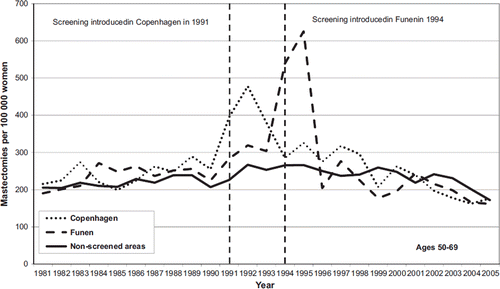To the Editor,
Invitations to breast screening and information from public authorities and cancer charities have often promised that screening leads to less invasive surgical therapy [Citation1]. Since the purpose of screening is to find cancer earlier, when it is smaller, it may seem obvious that screening should lead to less invasive surgery. However, screening increases the total amount of surgery because of overdiagnosis of harmless tumours. It also increases mastectomies because of detection of carcinoma in situ, which in the UK constitutes 20% of all screen-detected cancer, and which is treated by mastectomy in 27% of cases compared to 24% of invasive breast cancers [Citation2].
A recent position paper by Christiansen et al. in this journal concluded that screening has not increased the number of mastectomies in Denmark [Citation3]. This conclusion is not justified by the data presented.
As we have shown previously [Citation4], mastectomy rates in Denmark have decreased substantially over the past 10–15 years. However, these declines have occurred in both the screened age groups, in women too young to have been invited to screening, and in women above the screening age [Citation3]. We therefore need a control group to decide whether breast screening changes the use of mastectomies, which we have in Denmark, as screening was only offered in areas corresponding to 20% of the population for 17 years. The introduction of breast screening in Denmark led to substantial increases in mastectomy rates (). Christiansen et al. have previously criticised that mastectomy rates varied from 27% to 70% between non-screened areas in Denmark, indicating that a major source of changes in mastectomy use is variation in surgeon preferences and local practice, not screening [Citation5]. It seems likely that this variation was greatest between the non-screening areas, for reasons unrelated to screening. This complicates interpretation of the data, but the available data do not allow the conclusion that the initial increases in mastectomies were compensated for later on, as the subsequent declines in rates were similar in screened and non-screened areas () [Citation4].

The six years of additional follow-up in the recent paper by Christiansen et al. did not change this observation. We have reproduced the authors’ graphs for the screened age group in Denmark and have put them in the same figure so that they can be compared (). As for all other graphs in the paper by Christiansen et al., rates from the pre-screening period were not included but can be seen in our figure (). The reason that the graphs produced by Christiansen et al. and us are not identical is that we used different data sources [the Danish Breast Cancer Group’s database (DBCG) and the database at the National Board of Health, respectively].
![Figure 2. Mastectomy rates in screened and non-screened areas in Denmark. Data from DBCG [3]. Data from the pre-screening period were not provided.](/cms/asset/d40fb839-380d-46a5-905d-55a4dcc36c1c/ionc_a_920958_f0002_oc.jpg)
As in other countries [Citation6], the declines in mastectomy use in Denmark are largely driven by changes in treatment policy and specialisation of care at the national level, not screening use. The regional differences in treatment practices mean that the DBCG data cannot provide a precise estimate of the impact of breast screening on mastectomies, and the primary source of data should therefore be the randomised trials of screening. They showed a 20% increase in mastectomies (relative risk 1.20, 95% confidence interval 1.08–1.32) [Citation6].
Data from Norway, which had a staggered introduction of breast screening, are similar to those from Denmark and also showed an increase in mastectomies with screening [Citation7].
Given these facts, it is wrong to promise women that breast screening reduces their risk of a mastectomy. Breast screening seems to increase the risk of a mastectomy.
Declaration of interest: The authors report no conflicts of interest. The authors alone are responsible for the content and writing of the paper.
References
- Jørgensen KJ, Gøtzsche PC. Content of invitations for publicly funded screening mammography. Br Med J 2006;338:538–41.
- Patnick JNHS Breast Screening Programme: Annual review 2011. Sheffield: NHS Cancer Screening Programmes;2012.
- Christiansen P, Vejborg I, Kroman N, Holten I, Garne JP, Vedsted P, et al. Position paper: Breast cancer screening, diagnosis, and treatment in Denmark. Acta Oncol 2014;53: 433–44.
- Jørgensen KJ, Keen J, Gøtzsche PC. Is mammographic screening justifiable considering its substantial overdiagnosis rate and minor effect on mortality?Radiology 2011;260:621–7.
- Available from: http://www.b.dk/danmark/ofre-brystkraeft-behandles-vidt-forskelligt [last accessed 13 May 2014].
- Gøtzsche PC, Jørgensen KJ. Screening for breast cancer with mammography. Cochrane Database Syst Rev 2013;6: CD001877.
- Suhrke P, Mæhlen J, Schlichting E, Jørgensen KJ, Gøtzsche PC, Zahl PH. Mammography screening and surgical breast cancer treatment in Norway: Comparative analysis of cancer registry data. Br Med J 2011;343:d4692.
